Physical Address
304 North Cardinal St.
Dorchester Center, MA 02124
A complete surgical resection with negative margins is the primary goal when treating malignant tumors of the parotid gland. Preparation for surgery includes clinical evaluation of the patient, physical examination, including testing facial nerve function, cytologic evaluation for diagnosis, and detailed radiologic imaging evaluation for extent of disease. Imaging evaluation of parotid tumors is important, not only to document the extent of disease and establish a baseline for future comparisons, but some imaging modalities have also been shown to differentiate malignant from benign parotid tumors. The surgical approach is chosen according to the size and histologic grade of the primary tumor. If the tumor is small, low-grade, and confined to the superficial lobe of the parotid gland, a partial parotidectomy is the treatment of choice (see Chapter 35 ). Larger high-grade tumors might require more extensive resection, including sacrifice of the facial nerve, with or without neck dissection. Some advanced tumors may require resection of adjacent structures such as the auditory canal, the ascending ramus of the mandible, and temporal bone; details of these techniques are outside the scope of this chapter and are available elsewhere. Patients whose tumors are more advanced and in the deep lobe of the parotid are at greater risk of having long-term complications and they should be counseled preoperatively.
If clinically obvious facial nerve deficit from tumor involvement is present, sacrifice of the nerve or the branches that are involved is indicated. However, if the nerve is functioning, the decision to sacrifice it is made intraoperatively. The nerve is not amenable to salvage if it is encased by the tumor, because splitting even benign tumors that encase the nerve will result in local recurrence. However, resecting a functioning nerve for the sole purpose of achieving a “wide” margin is not recommended when the tumor does not involve the nerve. Although the decision to sacrifice the nerve or its branches is intraoperative, the surgeon must discuss this possibility and its consequences with the patient and the surgical consent should cover this possibility.
The skin incision is performed as described in superficial parotidectomy (see Chapter 35 ). If the skin is invaded by the tumor, the incision should be planned to incorporate an overlying skin island that will be resected accordingly. In cases of locally recurrent tumor, the surgical access should be through the previous parotidectomy incision and the scar should be excised. When elevating the skin flaps, the great auricular nerve (GAN) should be identified and preserved whenever possible. This can be very difficult in patients who had a previous parotidectomy. A segment of this nerve can be used as a graft to reconstruct the resected segment of the facial nerve. The facial nerve should also be identified and the segments and branches that are not involved by the tumor should be preserved. Fig. 47.1.1 shows a mucoepidermoid carcinoma (MEC) with gross invasion of the upper division of the facial nerve. Fig. 47.1.2 illustrates a recurrent parotid tumor encasing the lower division of the facial nerve. After the resection of the tumor and sacrifice of the involved branches of the facial nerve, the margins of the stumps are examined by frozen section to evaluate tumor involvement ( Figs. 47.1.3 , 47.1.4 ). Even when the nerve margin is “negative” in histologic evaluation, there can be further perineural spread, especially in adenoid cystic carcinoma (ACC), which is well known to have skip areas of normal nerve. Fig. 47.1.5 shows reconstruction of the upper division of the facial nerve using GAN graft (see Chapter 50 ). After the resection and nerve grafting, hemostasis and incision closure are done after the drain has been placed.
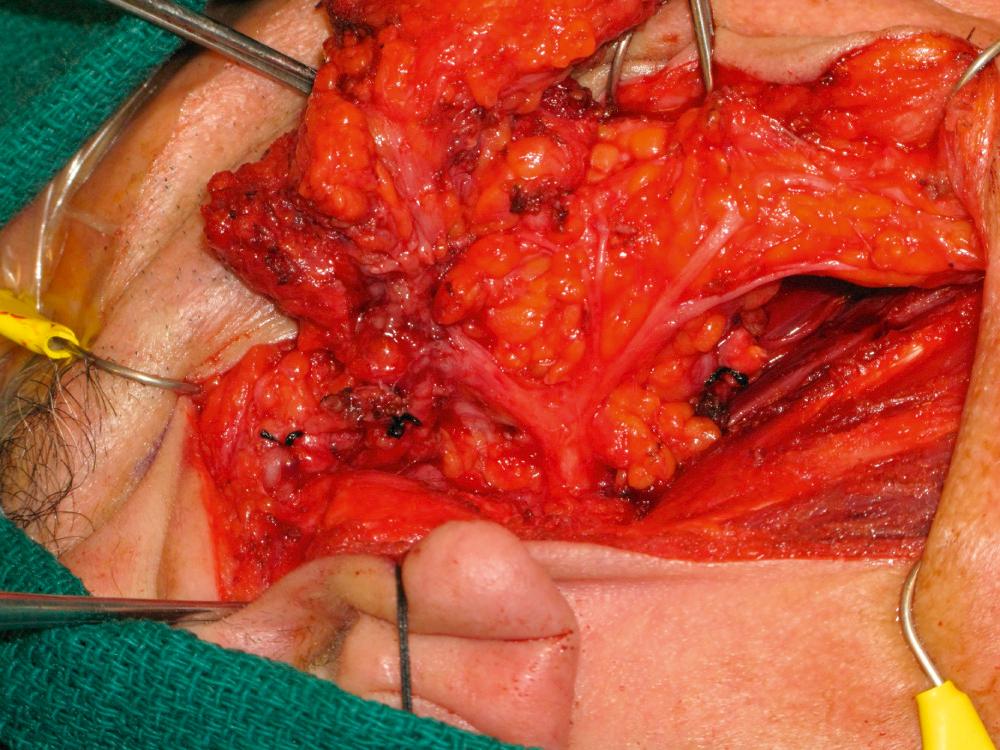
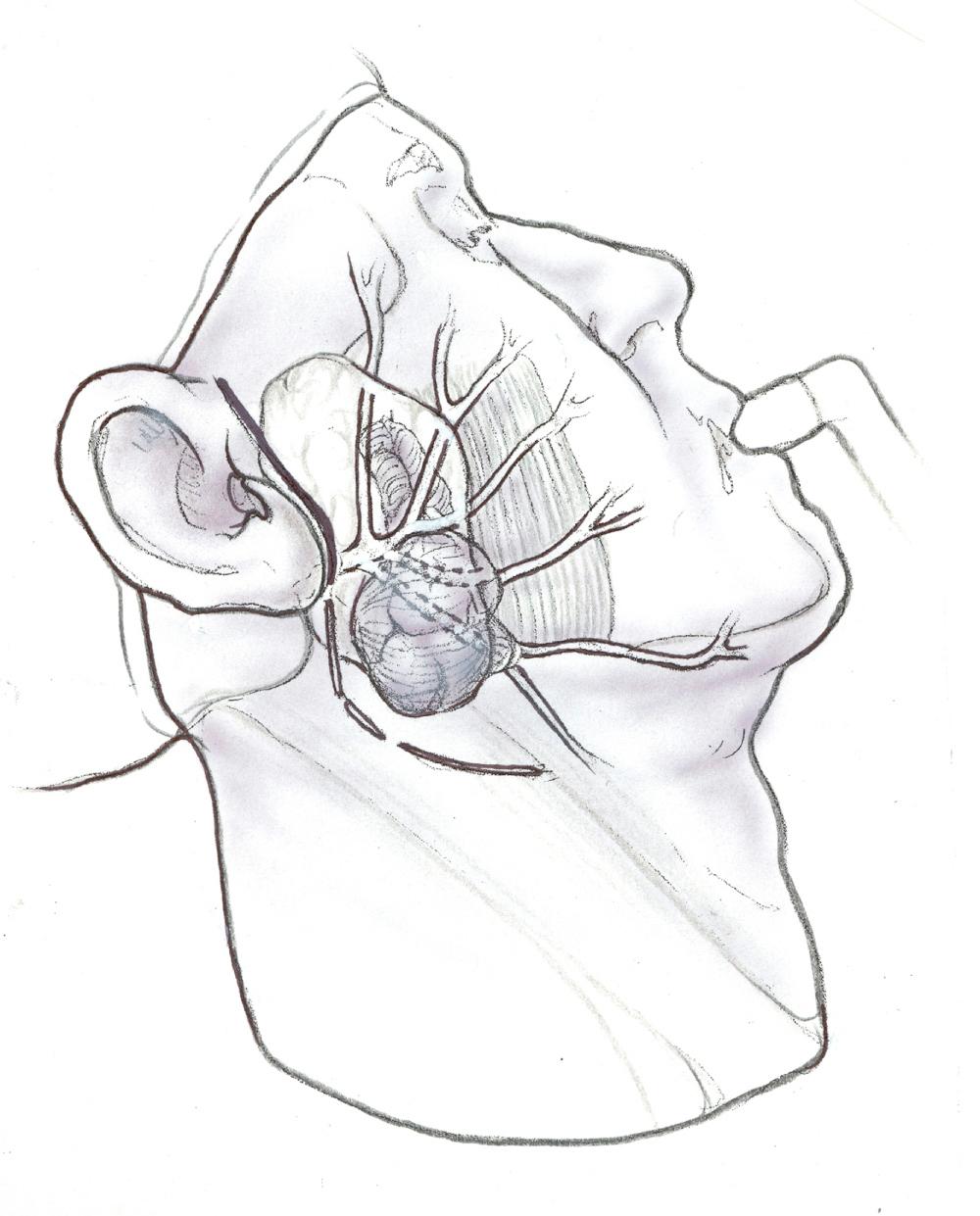
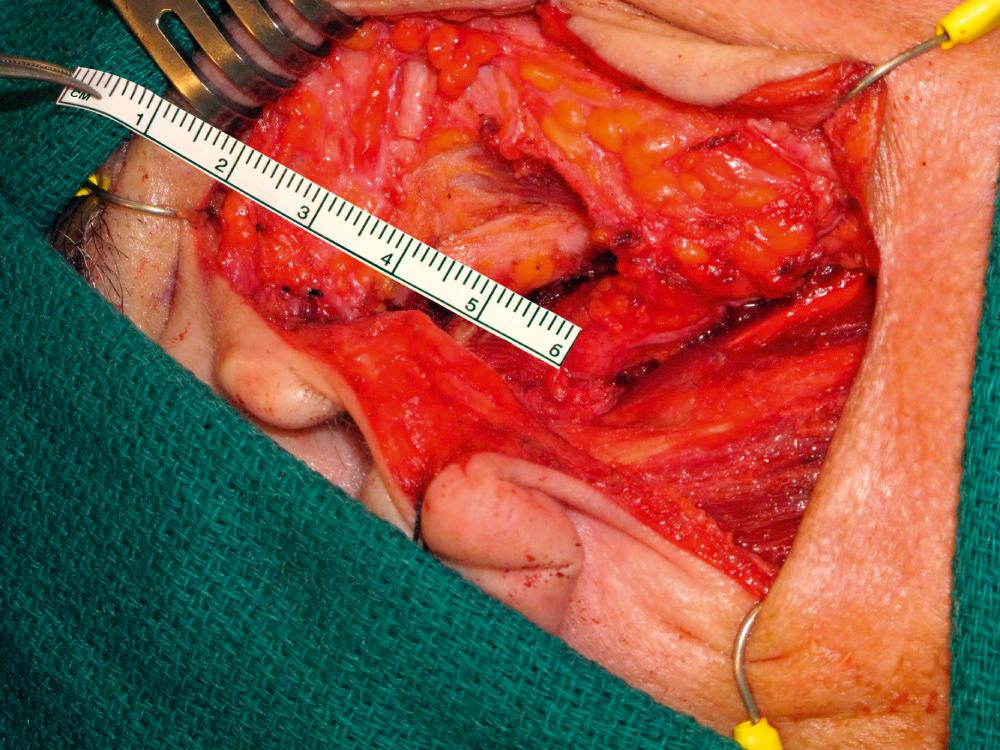
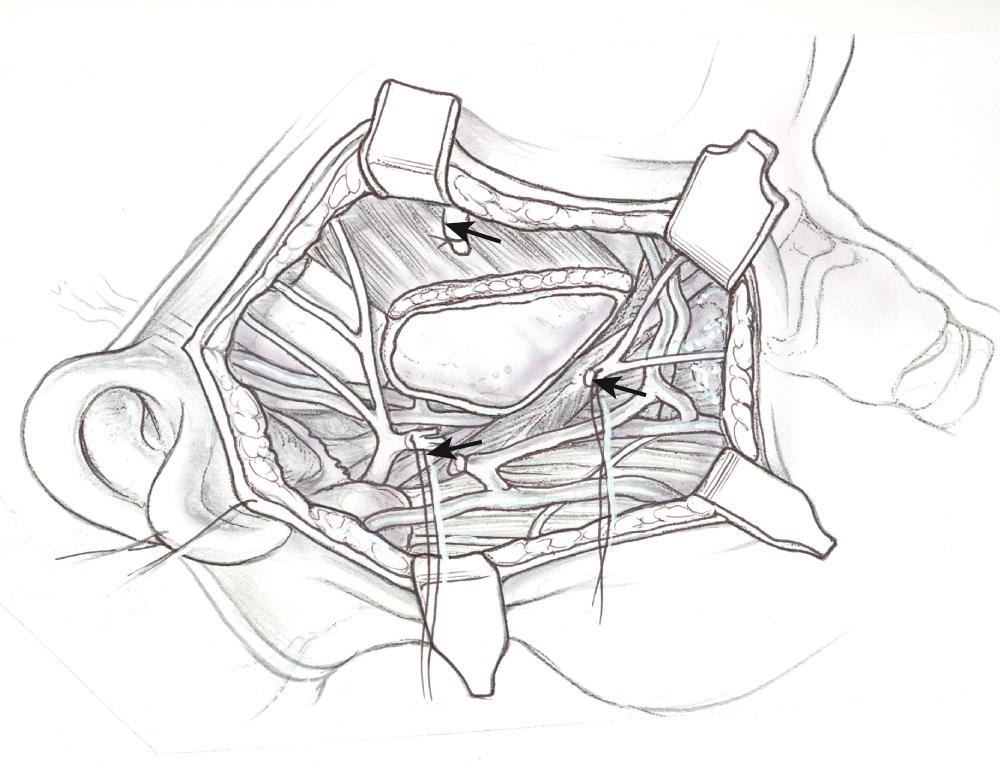
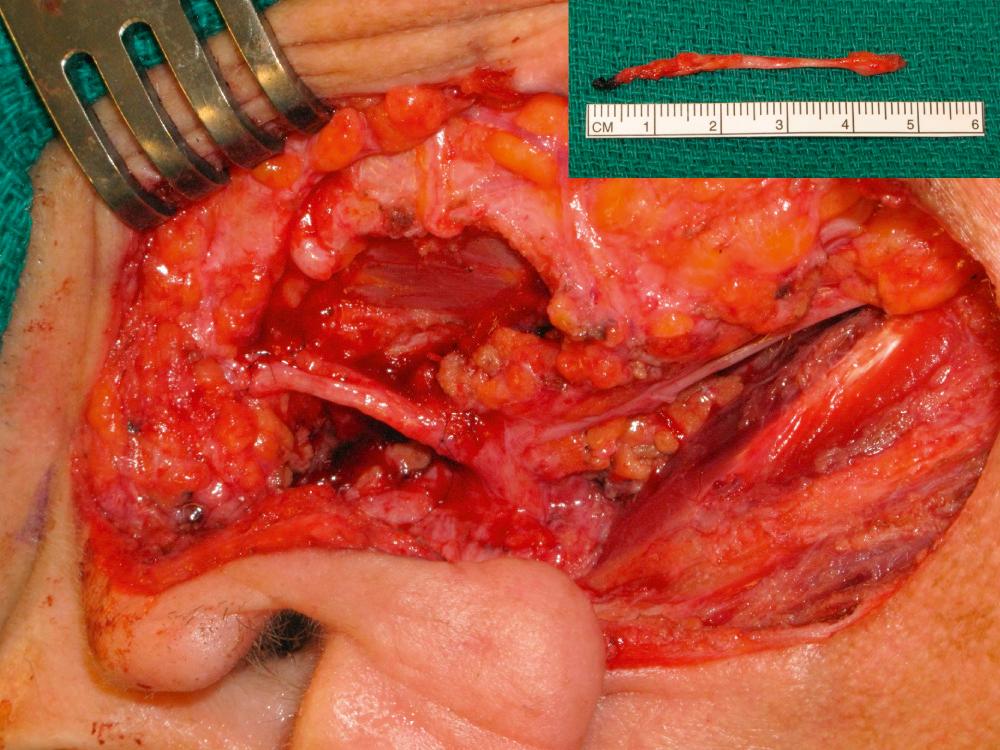
Transcervical resection, described in detail in Chapter 35 , is feasible for most tumors of the deep lobe of the parotid gland. Some malignant tumors though, especially locally recurrent or tumors that were previously violated by an attempted transoral biopsy, benefit from an exposure that provides direct visualization of the parapharyngeal space. A more comprehensive exposure of the parapharyngeal space can be achieved with the mandibulotomy approach. This surgical technique has been well described in the literature for oropharyngeal tumors.
The preferred osteotomy to assess parapharyngeal tumors is the paramedian mandibulotomy. This position is preferred because it allows wide exposure with the following advantages:
It preserves the sensation of the chin, lower lip, and teeth (there is no need of division of mental or inferior alveolar nerves)
It does not require dental extraction
It only requires division of the mylohyoid muscle (there is minimal interference with mastication or swallowing)
It is anterior in the oral cavity, which makes the postoperative care easier and keeps the osteotomy and the hardware that is used to fix it out of the way of radiotherapy portals, if adjuvant treatment is needed.
The skin incision for a lower cheek flap is planned and is extended toward the preauricular region to provide access for the parotidectomy ( Fig. 47.1.6 ). A superficial parotidectomy with identification of the facial nerve and its branches as described in Chapter 35 is the initial step of this operation. A comprehensive neck dissection is then completed when indicated. In preparation for the paramedian mandibulotomy, the lower lip is sharply incised in the midline in full thickness until about 0.5 cm from the gingivolabial sulcus and the mucosal incision continues for approximately 2 cm laterally. The soft tissue superficial to the periosteum is then carefully elevated stopping close to the mental foramen, keeping the nerve intact. The osteotomy is designed medially to the mental foramen and the periosteum is incised. Before the bone is sectioned, two titanium miniplates are positioned, on the anterior and inferior surfaces of the mandible ( Fig. 47.1.7 ). Drill holes to mark where the miniplates will be used to fix the bone are made carefully to avoid injury to the dental roots. The miniplates are saved for later use. Using a high-speed power saw with a fine blade, the osteotomy is started on the upper border in the space between the canine and the lateral incisor tooth. After completing the vertical limb of the mandible incision, the angled limb is started from the lower border of the bone. This bone incision should stop just before it reaches the vertical limb and the final cut can be done with the use of a fine osteotome to prevent overriding with the power saw. The segments of the bone are retracted and the mucosa is incised starting anteriorly where the bone cut was made and extending posteriorly into the floor of the mouth keeping a 1 cm cuff of mucosa attached to the lower gingiva to facilitate a safe closure ( Fig. 47.1.8 ). The hypoglossal nerve is preserved and the incision continues posteriorly toward the anterior tonsillar pillar. If the mucosa of the lateral oropharynx had been violated by a previous transoral biopsy or attempted resection, this mucosa should be included in the resection, and the incision should be adapted for that purpose ( Fig. 47.1.9 ). The mylohyoid muscle is divided and the parapharyngeal space is adequately exposed ( Fig. 47.1.10 ). A superficial parotidectomy is completed to identify the facial nerve, which is dissected off the deep lobe tumor, if not invaded, and gently retracted cephalad. The tumor can now be circumferentially mobilized with the exposure provided by the mandibulotomy. The tumor is resected in a monobloc fashion. A flap is needed to reconstruct the pharyngeal wall if a significant amount of mucosa had to be resected. Hemostasis is ensured and a nasogastric feeding tube is inserted and secured. Interrupted Vicryl sutures are used to repair the mucosal incision starting from posterior toward the anterior floor of the mouth. The miniplates and screws are now used to fix the mandible ( Fig. 47.1.7 ). Before the mucosa of the lower lip is closed, a 5-0 nylon suture is used to align the vermilion border and to guide the closure of the gingivolabial sulcus and lower lip. The muscle layer and the mucosa are closed with interrupted 3-0 Vicryl, in separate layers. Before proceeding with closure of the neck, the mylohyoid muscle is repaired with 3-0 Vicryl sutures. Closed-suction drainage is used in the neck away from the facial nerve and its branches. The neck incision is then closed in two layers.
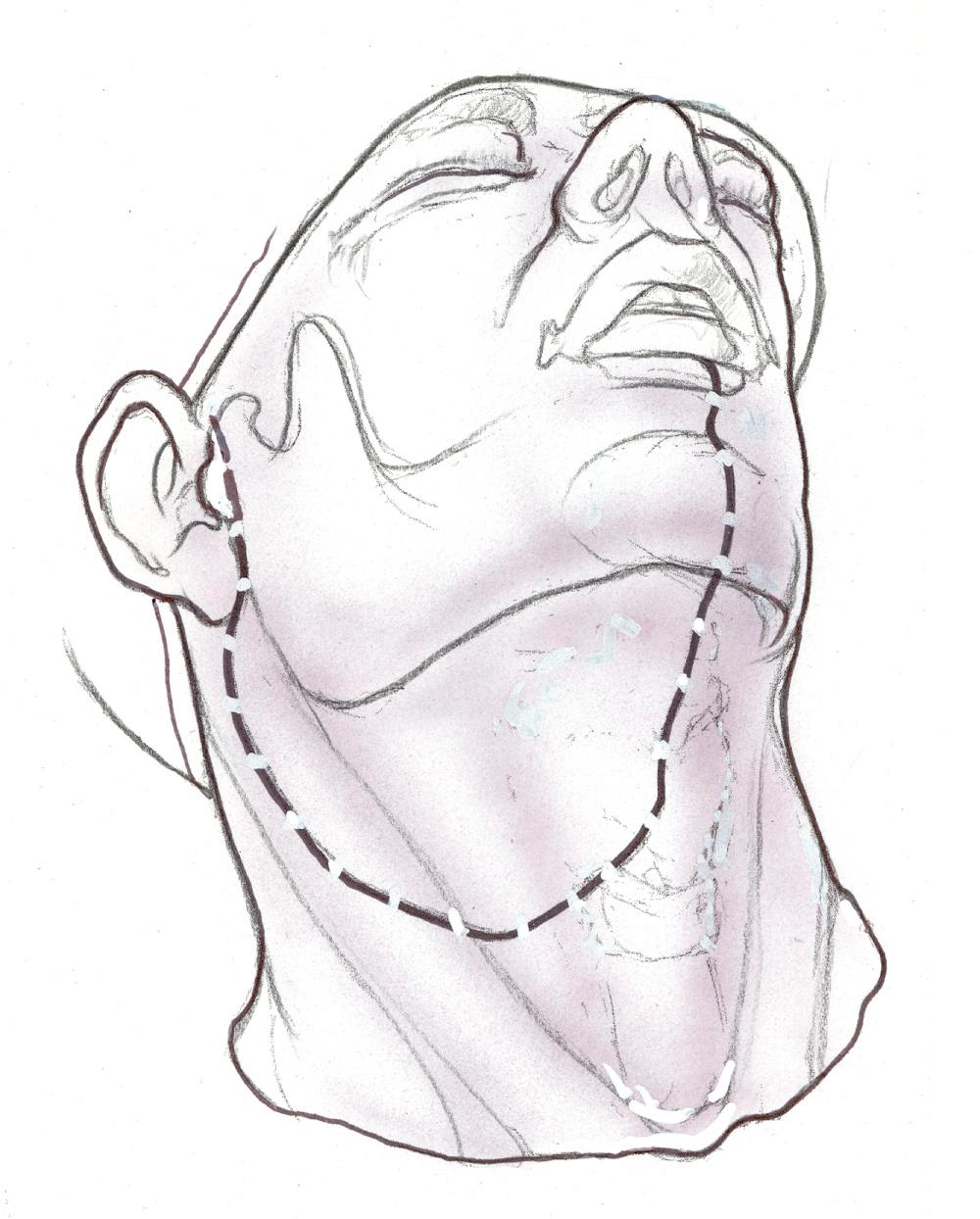
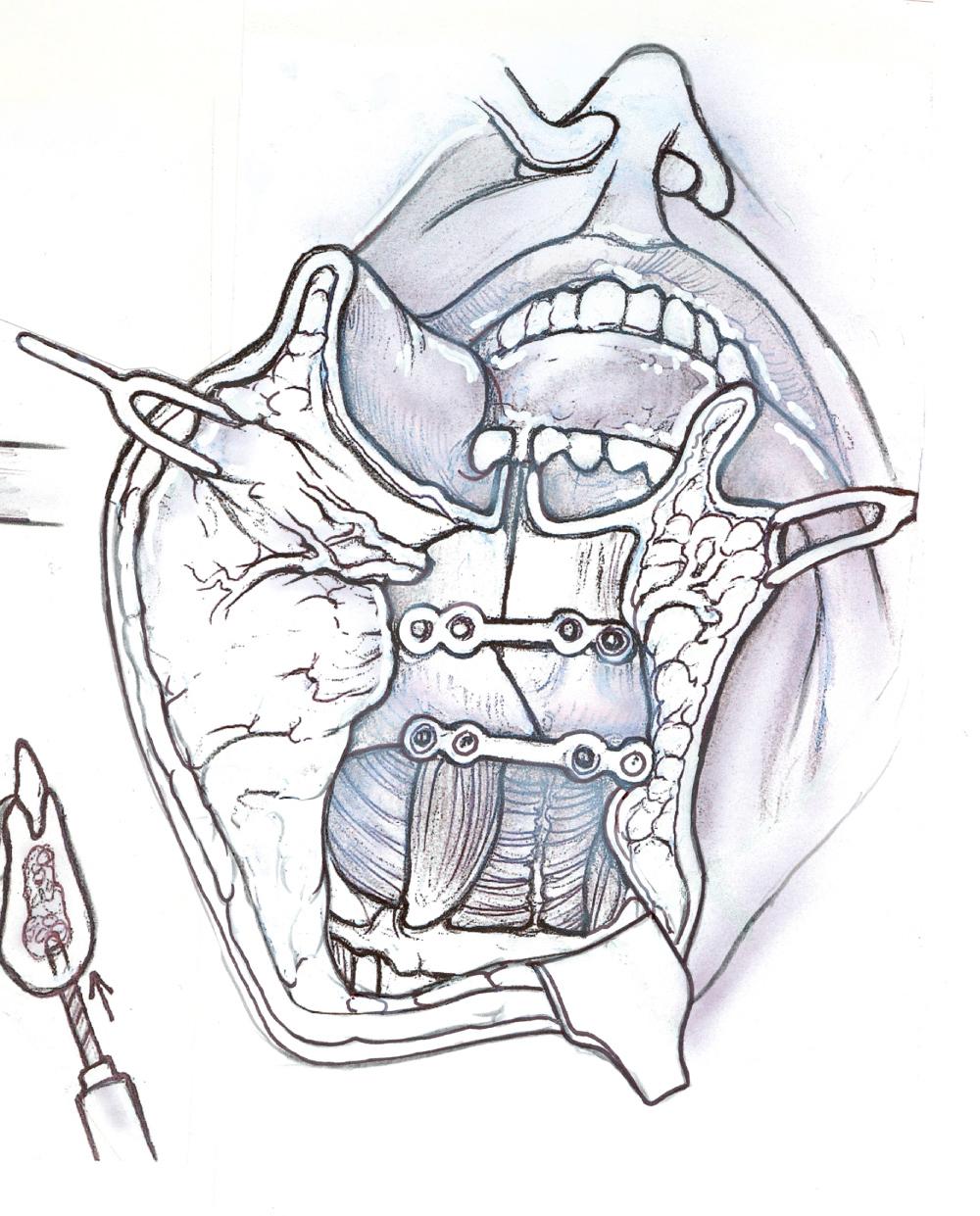
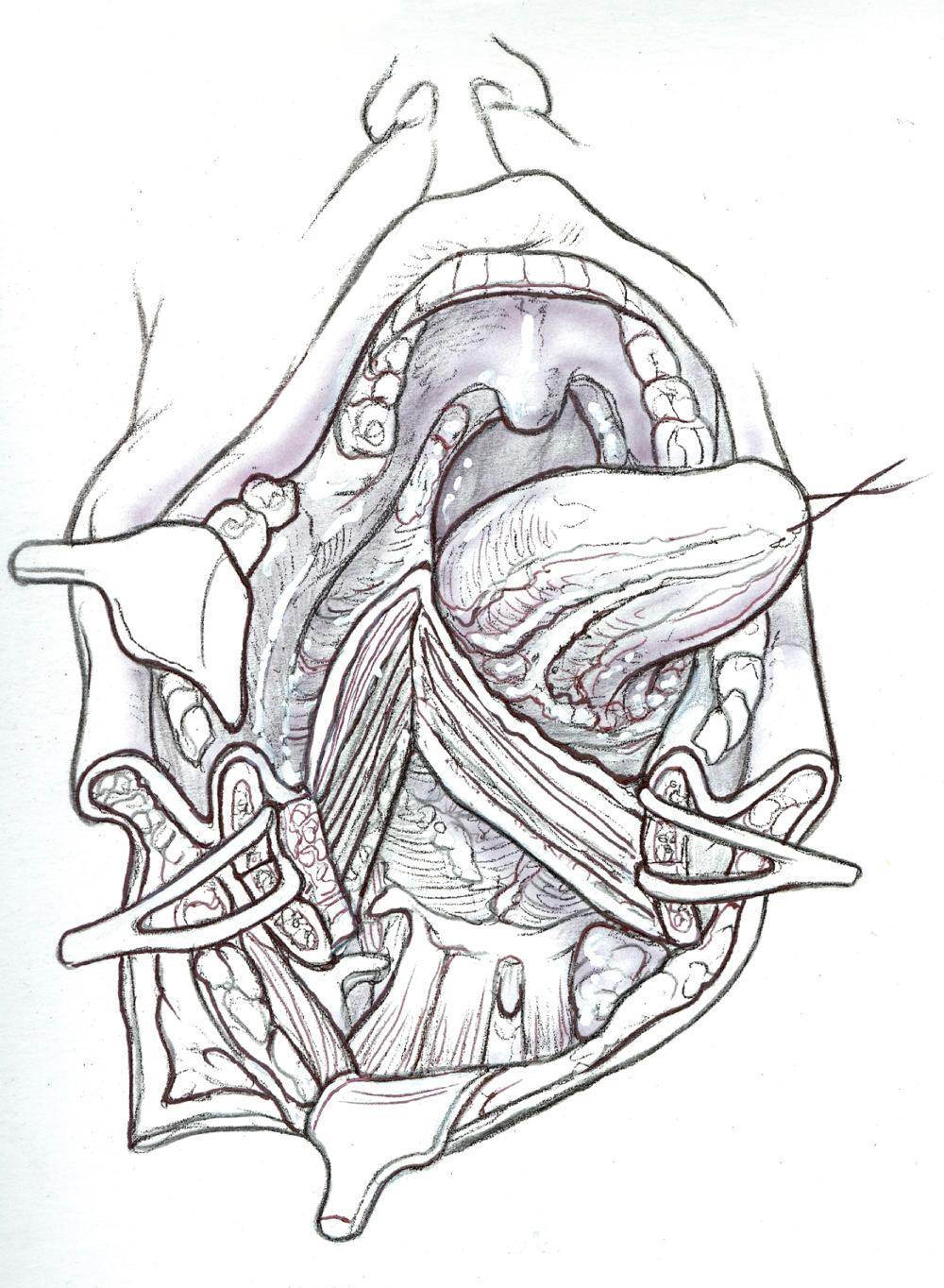
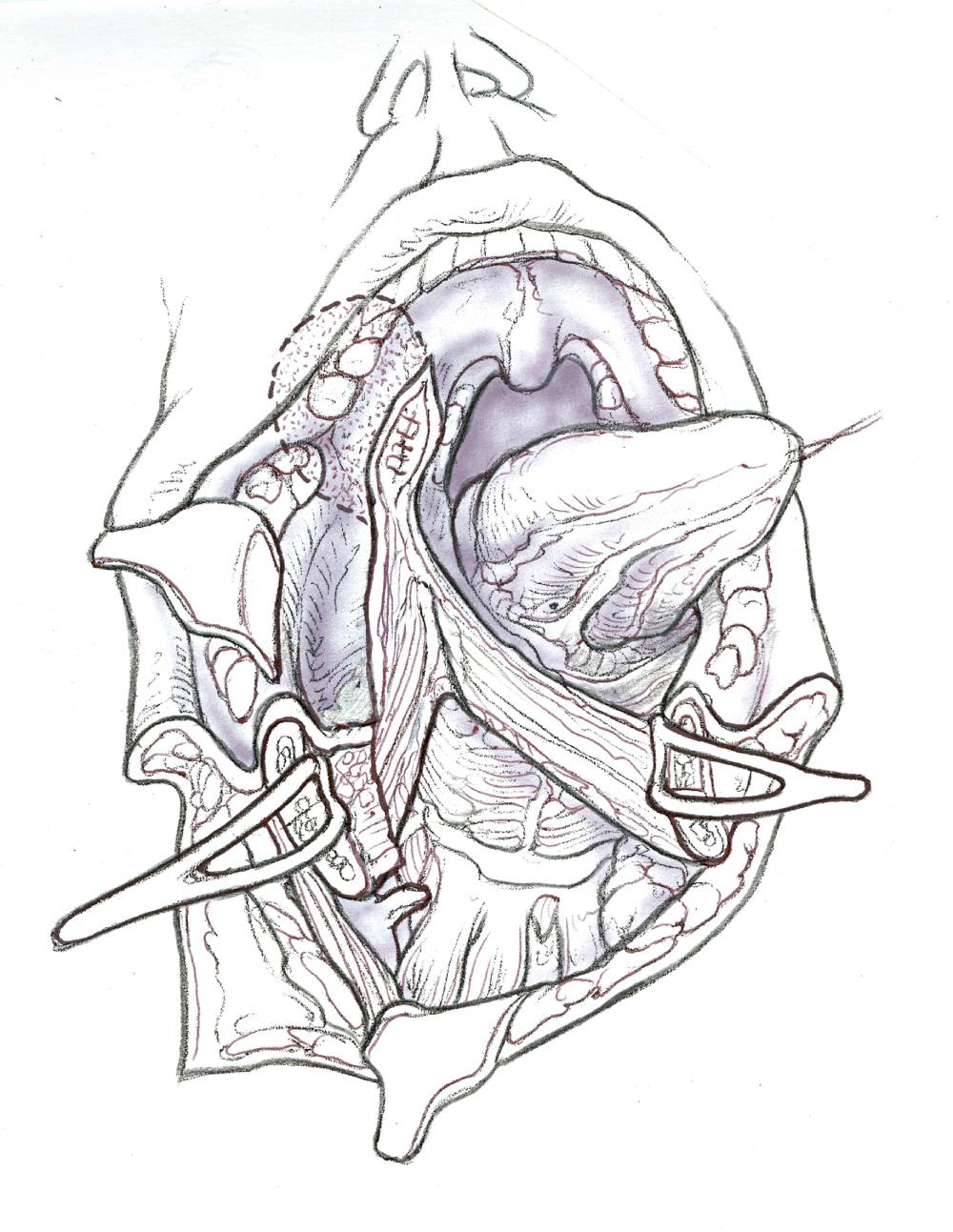
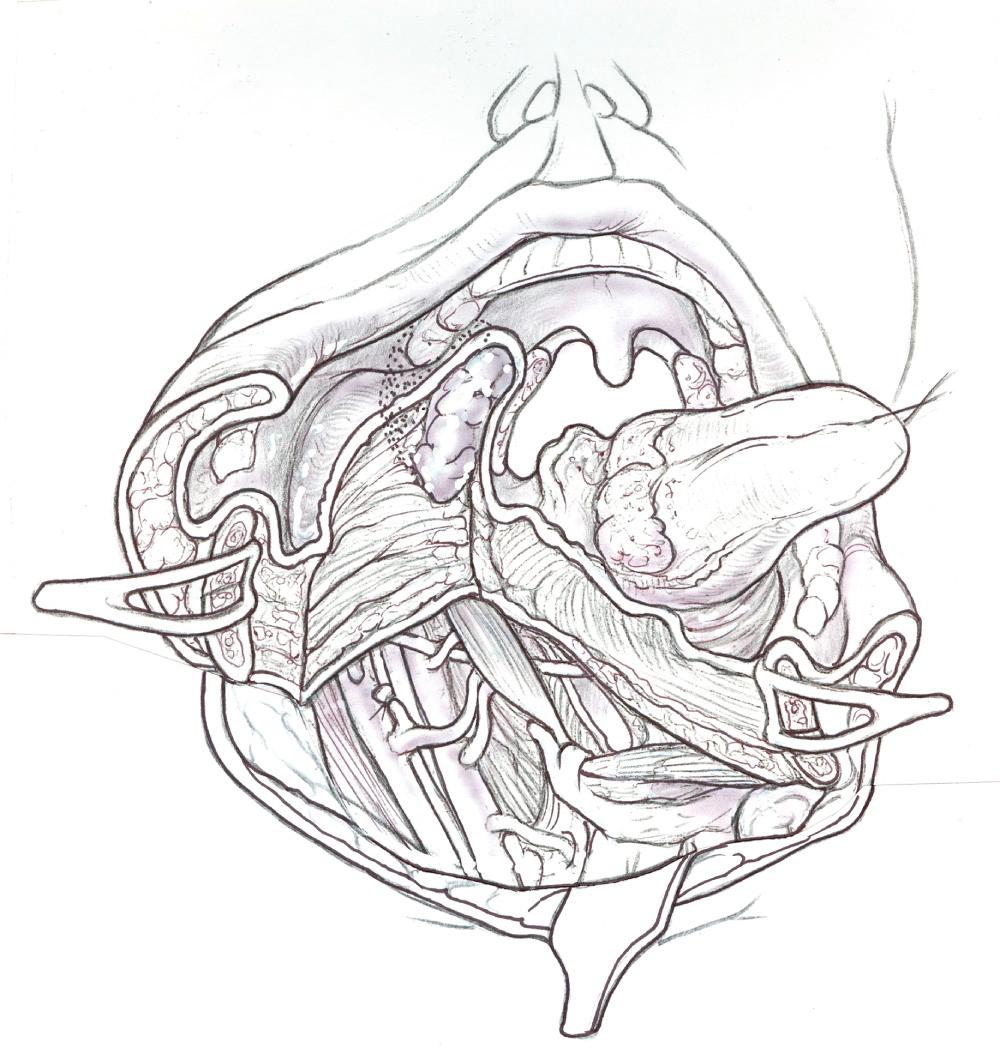
The patient is kept with nasogastric tube feeding for a week and after this period, a trial with pureed food is made. If the trial is successful, the patient's food intake is advanced gradually to a soft diet. Once the patient's oral intake suffices the daily nutritional requirement, the nasogastric tube can be removed. Oral hygiene is essential for healing and to avoid infection at the osteotomy site.
Postoperative care for all cases of advanced malignant tumors in the parotid gland should include a multidisciplinary team to evaluate and help in rehabilitating the patient's speech, swallowing, facial motricity, and lymphatic drainage for the face and neck.
If the tumor is small, low-grade, and confined to the superficial lobe of the parotid gland, a partial parotidectomy is the treatment of choice.
Resecting a functioning nerve for the sole purpose of achieving a “wide” margin is not recommended.
The preferred osteotomy to assess parapharyngeal tumors is the paramedian mandibulotomy.
An estimated 25–50% of submandibular gland tumors are malignant, with a wide range of histologies and biologic activity. ACC, the most common primary malignancy of the submandibular gland, has a predilection for perineural spread and late distant metastases. Other common malignant histologies may also demonstrate invasive locoregional disease and have an increased risk of metastases.
Surgical management remains the standard of care for submandibular gland malignancies. In patients with initial gland enucleation who subsequently underwent definitive surgical resection, over 60% were found to have residual carcinoma. Although all submandibular masses harbor the potential for malignancy, fine needle aspiration (FNA) in some cases will suggest malignancy and therefore indicate an oncologic approach. Optimal management of submandibular gland malignancy, therefore, requires adequate preparation for appropriate tumor exposure, full resection of the gland in continuity with surrounding lymphatics and involved structures, along with the ability to perform any required reconstructive procedures when necessary.
Become a Clinical Tree membership for Full access and enjoy Unlimited articles
If you are a member. Log in here